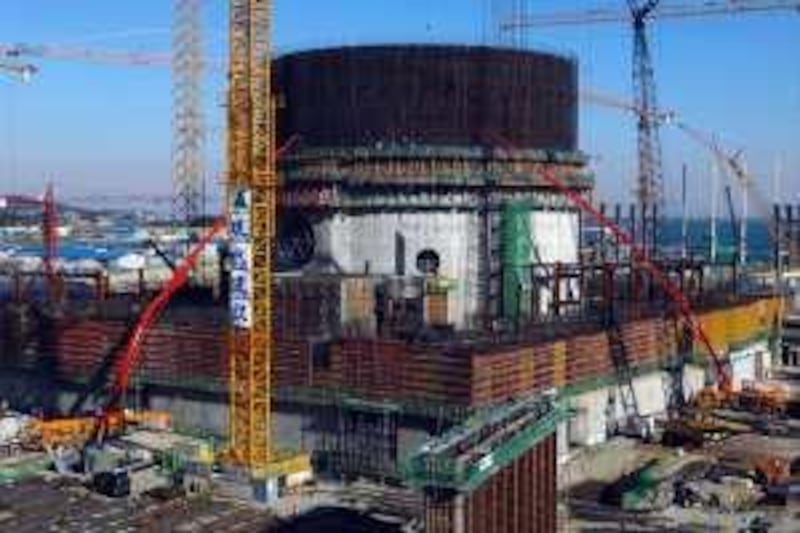KORI // The four imposing reactors at the birthplace of South Korea's nuclear programme rise from a point on the verdant coastline, their grey domes surrounded by drab square buildings. The construction site at Kori where South Korea is building its newest reactors, plants similar to those planned for the UAE, are a hive of activity. The existing reactors, the first of which was built in 1978, are silent, however. And that is just how the South Koreans like it.
The plants here are almost never shut down for technical trouble, a point of pride for a country that set out to make nuclear power a low-risk commodity. Together, South Korea's plants now supply as much as 40 per cent of the country's electricity. Chae Wan Hee, a vice president for Korean Hydro and Nuclear Power at the site, said the company's safe operating history comes down to rigorously training workers in the nuclear plants "to prevent human-incurred accidents in operation and maintenance".
Next door to the operating plants - at the construction site of the point's seventh nuclear plant - the first model of a new design is coming together in a set of modules that are lifted into place by tall cranes. The 5,000 workers are running ahead of their target to have the plant operating by September 2013, and officials say they have yet to sustain a single injury on the work site since construction started more than two years ago.
The uniform and highly disciplined approach to nuclear plant construction is the key to why the Emirates Nuclear Energy Corporation (ENEC) awarded a US$20 billion (Dh73.46bn) contract last month to Korea Electric Power Corporation (KEPCO) to build a fleet of reactors in the UAE. ENEC officials said they were convinced that the Korean firms could construct four highly efficient reactors by 2020 at relatively low cost.
ENEC has a long-term plan modelled on the Korean system of uniform design and economy of scale: it intends to build all four reactors at the one site it eventually chooses, and also has signalled that it would prefer to stick with the same design as reactors are added. But in the meantime, expansion at Shin Kori, the new side of the Kori site, will go on. By the end of 2014, this cluster of nuclear reactors will grow to eight and generate an amount of electricity equivalent to the consumption of Abu Dhabi emirate on the hottest summer day.
South Korea's nuclear programme extends well beyond Kori: a total of 20 reactors are operating at four sites across the country. The government intends to increase that figure to 60 per cent by 2030. South Korea's uniform approach to reactor construction and operation has paid off in lower costs and has demonstrated that big innovations may not be the most cost-effective route to going nuclear.
"Advanced technology is good for marketing, but when it comes to design and construction, it causes difficulties," said Dr Kim Shin-whan, a nuclear engineer and manager of business development at Korea Power Engineering Company, the KEPCO subsidiary that designs reactors. The country's fleet of reactors generates electricity at an average cost of 40 won (Dh0.12) per kilowatt-hour over their lifetime of operation - 2 won less than the country's coal-fired power plants, said Dr Whang Joo-ho, a nuclear expert at Kyung Hee University who was appointed by the government in 2004 to lead a committee to determine the true cost of nuclear power.
His findings, which included "hidden costs" such as the price of retiring the plants and finding a solution to nuclear waste, more than doubled industry estimates for nuclear energy's cost at the time. But the figure is still substantially lower than costs for producing electricity from nearly any other source. "I would be very comfortable in saying this is the full cost nowadays," Dr Whang said. "Why are we saving money? The first thing is we've been lucky to have vertically or serially arranged companies" that incorporate the full range of expertise needed to build a reactor.
"Moreover, at one point we were completing one unit every year, so [the companies] got experience for engineering, procurement or construction." @Email:cstanton@thenational.ae





